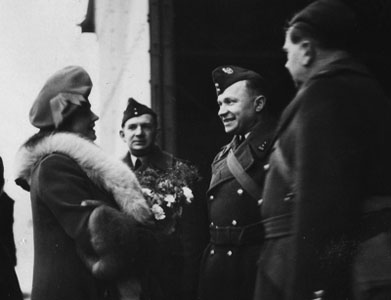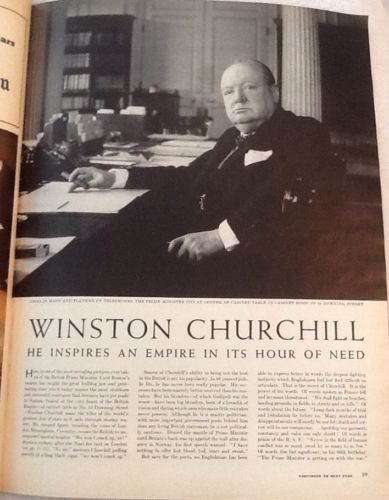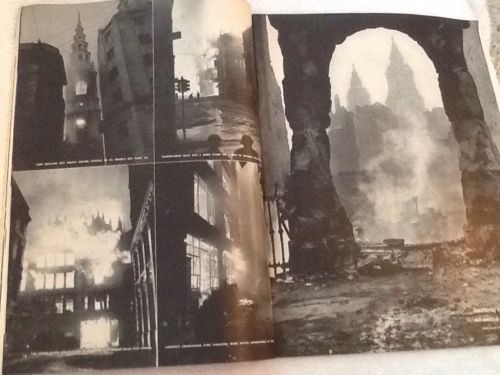Monday 10 March 1941
 |
| The King and Queen visit Dundee, 10 March 1941. © IWM (A 3383). |
Operation Lustre, the British reinforcement of Greece, continues. The troop convoys from Alexandria and Suda Bay are arriving every three days. So far, the first troop tranche has arrived at Piraeus, and the second is en route.
East African Campaign: At Keren, Eritrea, Lieutenant-General William Platt remains frustrated at his troops' inability to fight through the narrow Dongolaas Gorge. The fierce Italian resistance at Keren is the only thing standing between the British and the coast at Massawa. Platt is assembling his troops for another attempt at the middle of the month.
Keren is a key crossroads whose capture will enable the British to scoop up all of Eritrea and head south into Abyssinia toward Addis Ababa, which is being threatened by the South African advance far to the south. Once the British are past Keren, the entire Italian position in East Africa will become unhinged - but there are very few routes in this rough country that are able to support large military operations. So far, attempts to flank Keren using secondary routes have produced no results.
Far to the south, the South African forces continue to advance north from the vicinity of Mogadishu. Operation Canvas continues without any meaningful results despite swallowing large amounts of territory. Now about 500 miles (900 km) past it, the Italian resistance begins to stiffen forward of the fortress of Jijiga, Abyssinia. The Italians top the 23rd Nigerian Brigade of the British 1st African Division at Dagabur (Degehabur), about 100 miles (160 km) south of Jijiga.
Belgian Congolese troops, meanwhile, cross the border into Abyssinia from the west and take Italian base Asosa.
 |
| Battery "Pooh," located at St. Margaret's near Dover, on 10 March 1941. It is a 14-inch gun designed to counter the German batteries at the Pas de Calais at Hellfire Corner. |
The Luftwaffe raids Portsmouth after dark for the second night in a row. It is one of the most devastating raids outside of London for some time. The Germans put around 240 bombers over the city, the most since 1940, and cause extensive damage to the docks and shipping. They sink a minesweeping trawler, HMT Revello, killing one man, and damage destroyers HMS Sherwood, Tynedale and Witherington, training ship HMS Marshal Soult and four other minesweeping trawlers. Four sailors on shore also perish.
RAF Bomber Command raids Le Havre. While just another raid against a Channel port, this is the first raid by Handley Page Halifax bombers by No. 35 Squadron flying out of Yorkshire (Linton-on-Ouse). One of the Halifax bombers (L9489) goes down over Hog's Back in Surrey, killing four of the six crew, crashing on fields near Merrist Wood, Worplesdon. This is what is known as a "nursery raid," the first operational raid by new equipment which is intended as much to test it operationally as to produce actual results. The crash is a friendly fire incident, as the bomber is shot down over England by an RAF night fighter (Squadron Leader P A Gilchrist DFC) whose crew is completely unaware that it just shot down one of its own planes. One of the engines will be recovered from the field in 1996, and a plaque will be erected on the lonely spot on 8 March 1997.
Other RAF targets during the night are Cologne (19 bombers) and St. Nazaire (14 bombers). The RAF also conducts Rhubarb sweeps over the French coast during the day.
Australian Prime Minister Robert Menzies writes down in his diary his impression of the Blitz:
Curious to see the North Lodge at Buckingham Palace lying in ruins this morning. Houses shattered in Curzon Street. Germans are poor psychologists. If they had left the West End alone the East Enders might have been persuaded that they alone were bearing the brunt of the war. And Buckingham Palace again! ha ha!Of course, the German bombs at Buckingham Palace came within whiskers of killing the King, which would not have been such a laughing matter.
 |
| The Reykjaborg, sunk by U-552 today. |
A convoy of British freighters blunders into a minefield off Hastings. Three ships sink:
- 870-ton Corinia (14 deaths)
- 708-ton Sparta (9 deaths)
- 1107-ton Waterland (7 deaths)
The Luftwaffe attacks a freighter off Wexford in St. George's Channel. It is the 4343-ton Norwegian ship Bur. The Bur is damaged and barely makes it to Fishguard, where the captain beaches it. The ship is repaired at Barry in the Bristol Channel. Another freighter, 391-ton Dutch ship Libra, also is damaged and towed into Swansea.
Royal Navy submarine HMS H.28 is damaged by a collision with an unidentified freighter in the Irish Sea. Repairs in Belfast take until mid-April.
German supply operations in the Atlantic operate without much hindrance these days. German tanker Nordmark rendezvouses with supply ship Alsterufer.
German minelayers lay minefield Pregel as part of minefield Westwall.
Convoy OB 296 departs from Liverpool, Convoy SC 25 departs from Halifax.
Destroyer HMS Chiddingfold is launched.
Battle of the Mediterranean: Royal Navy aircraft carrier HMS Formidable completes its journey to join the British Mediterranean Fleet at Alexandria. HMS Illustrious, badly damaged but seaworthy, departs from Alexandria for Port Said.
Royal Navy submarine HMS Unique torpedoes and sinks Italian freighter Fenicia 160 km (100 miles) north of Tripoli.
In Malta, there are repeated attacks by the Luftwaffe throughout the day. At 12:21, nine German Bf 110s strafe the Sunderland flying boats in St. Paul's Bay, destroying one and damaging two others. In addition, a fuel lighter has to be beached with damage. The defending Hurricanes shoot down one of the Bf 110s. After dark, up to 20 bombers attack in bright moonlight, damaging Luqa Airfield and various other points on the island.
Convoy BN 19 departs from Aden, bound for Suez.
Applied Science: Centimetric radar is being developed both by the Americans and the British, and today both countries try out a prototype mounted in a bomber. The USAAC uses a Douglas B-18 Bolo bomber to try out the radar, but it is a first test of the equipment with no real results beyond making sure the aircraft can handle it. The British are at the next stage in their development and today use the radar to make an air-to-air detection. It is hoped that centimetric radar will have useful applications in naval warfare.
Spy Stuff: Acting Japanese Consul General Ojiro Okuda is continuing his spying operations on the US Pacific Fleet. Today, he sends another message to Tokyo listing the ships present there on the 9th. This includes "Four battleships... Five heavy cruisers... Six light cruisers... [and the aircraft carrier USS] Yorktown."
 |
| French diplomat Gaston Henry-Haye on the cover of Time Magazine, March 10, 1941, | Vol. XXXVII No. 10 (Cover Credit: DAVID E. SCHERMAN). |
Nothing has since occurred to alter the view of His Majesty's Government that it is the responsibility of the German Government to see to the material welfare of the countries they have overrun, nor to weaken their conviction that no form of relief can be devised which would not directly or indirectly assist the enemy's war effort.Speaking to US journalists, Admiral Darlan, now Petain's chief deputy, warns:
I am responsible for feeding 40 million people, plus millions more in Africa. I will feed them even if I have to use force.The issue of humanitarian aid will remain throughout the war, with the US wishing to help the people of Europe, but the British government objecting on the grounds that any aid of any sort to countries controlled by the Germans will help the Axis war effort.
France confirms the Murphy-Weygand Agreement today. Pursuant to the agreement, the United States agrees to supply French North Africa with certain basic commodities, so long as the French do not build up stockpiles and do not export them.
Anglo/US Relations: The Lend-Lease Bill is not yet law, but President Roosevelt gets a jump on the process by requesting $7 billion in aid to England.
US Military: The USAAF 73rd Squadron (Douglas B-18s) begins transferring from McChord Field outside Tacoma, Washington to Elmendorf Field, Anchorage, Alaska.
Japanese Military: Japanese rear admiral Takijirō Ōnishi submits to Isoroku Yamamoto a plan for the Pearl Harbor attack.
British Government: There is a rare meeting of the War Cabinet at the Cabinet War Room bunker ("Paddock") located in Brook Road, Dollis Hill, northwest London. It is a massive, two-story underground facility under a corner of the Post Office Research Station site. The bunker is only used for two meetings during the war. Visiting Australian Prime Minister Menzies gives a summary of Australian achievements in the war to date.
Soviet Government: Nikolai Voznesensky becomes the First Deputy Chairman of the Council of People's Commissars of the USSR. Maksim Saburov becomes Chairman of the State Planning Committee.
 |
| "Squadron Leader James Wheeler, a Flight Commander of No. 85 Squadron RAF, gets into the cockpit of a Hawker Hurricane Mark I night fighter, 'VY-X', at Debden, Essex, for a sortie while taking advantage of the clear moonlit nights during the period of the full moon from 10-16 March 1941." © IWM (CH 2249). |
Vichy French Government: The Vichy government orders that, as of this date, compulsory ceremonies be conducted in every school Dahomey. This includes raising and lowering the French flag to the sounds of choral music.
Indochina: The Japanese mediate the French into giving the Thais everything that they originally sought. Thailand takes possession of all land up to the Mekong River. As their "fee," the Japanese take a monopoly on Indochinese rice production and basing rights for their planes at a Saigon airfield. This is a major expansion of Japanese influence in Indochina, which formerly was confined to the northern area around China.
Australia: Queensland's Public Works Department begins construction of the Rocklea Small Arms Factory/Munitions Works.
China: The Western Hupei Operation continues. Japanese 13th Infantry Division advances to take Kuankungling, Hutzuchung, and Hsianglingkou along the Yangtze River as the Chinese (Kuomintang) continue retreating on Chunking.
French Homefront: The Vichy government rations beer. It cannot be sold on Tuesdays and Saturdays.
German Homefront: The government constantly monitors public views about the war and toward the regime. These reports continue throughout the war and, unlike German propaganda, are as accurate as the preparers can make them. This week's report notes that hawking pictures of Hitler at fairs next to those of religious icons is meeting resistance with the public.
American Homefront: Following upon the test of batting helmets in Havana, Cuba, the General Manager Lee MacPhail of the Brooklyn Dodgers organization announces that the team's players will wear them throughout the season.
Future History: Naw Louisa Benson is born in Burma. She becomes Burma's first Miss Universe contestant in 1956 and again becomes Miss Burma in 1958. Benson joins the Karen National Liberation Army (KNLA) in 1964 and takes over command of her husband's brigade after he is assassinated.
 |
| On 10 March 1941, Transport Workers Union bus drivers in New York City go on strike over wages, hours, working conditions, and benefits. The strike halts most of Manhattan’s bus service. |
March 1941
March 1, 1941: Rettungsboje
March 2, 1941: Oath of Kufra
March 3, 1941: Germans in Bulgaria
March 4, 1941: Lofoten Islands Raid
March 5, 1941: Cooperation With Japan
March 6, 1941: Battle of Atlantic
March 7, 1941: Prien Goes Under
March 8, 1941: Cafe de Paris
March 9, 1941: Italian Spring Offensive
March 10, 1941: Humanitarian Aid
March 11, 1941: Lend Lease Become Law
March 12, 1941: A New Magna Carta
March 13, 1941: Clydeside Wrecked
March 14, 1941: Leeds Blitz
March 15, 1941: Cruisers Strike!
March 16, 1941: Kretschmer Attacks
March 17, 1941: Happy Time Ends
March 18, 1941: Woolton Pie
March 19, 1941: London Hit Hard
March 20, 1941: Romeo and Juliet
March 21, 1941: Plymouth Blitz
March 22, 1941: Grand Coulee Dam
March 23, 1941: Malta Under Siege
March 24, 1941: Afrika Korps Strikes!
March 25, 1941: Yugoslavia Joins The Party
March 26, 1941: Barchini Esplosivi
March 27, 1941: Belgrade Coup
March 28, 1941: Cape Matapan Battle
March 29, 1941: Lindbergh Rants
March 30, 1941: Commissar Order
March 31, 1941: Cookie Bombs
2020









